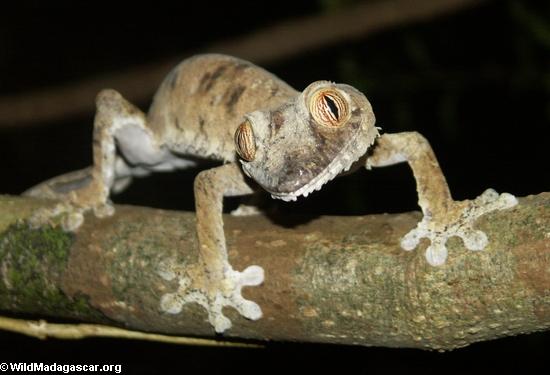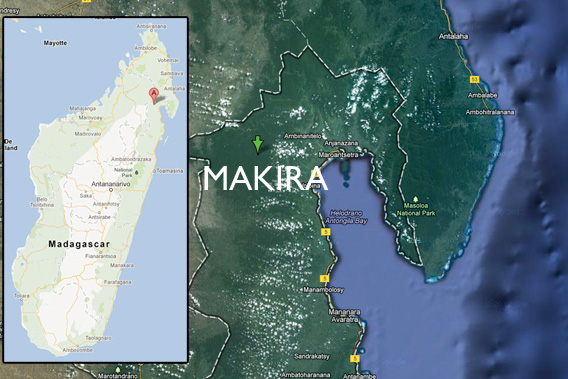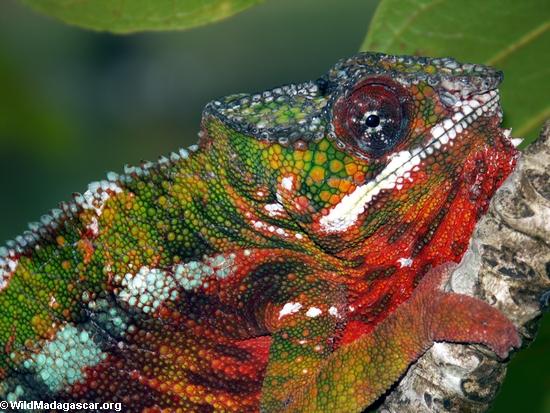
Leaf-tailed gecko in Madagascar. Photo by Rhett A. Butler
Madagascar officially designated its largest protected area in a region renowned for its tropical rainforests and rich diversity of wildlife, including 20 species of lemurs, reports the Wildlife Conservation Society (WCS), a group that was instrumental in establishing the park.
Makira Natural Park covers some 372,470 hectares (1,438 square miles) — an area larger than the state of Rhode Island — of forest in northeastern Madagascar, the most biodiverse part of the island nation. Makira was granted temporary park status in 2005 but is now officially designated as a protected area.
Management of Makira will be partially funded by the sale of carbon credits under the REDD+ (Reduced Emissions through Deforestation and Forest Degradation) program, a global framework that aims to compensate tropical countries for protecting their forests. The establishment of Makira will avoid an estimated 31 million tons of carbon emissions over 30 years. Half the proceeds from the sale of carbon offsets are returned to local communities living in and around the protected area.

Makira. Courtesy of Google Earth.
Christopher Holmes, Director of WCS’s Madagascar Program, said Makira could become a model for conservation projects elsewhere.
“Not only does Makira protect the largest remaining tract of the island’s rainforest, but it is a demonstration of a new model for integrated conservation in Madagascar where local communities – de facto stewards of the forest resources – become partners with the State in protected area management.”

Panther chameleon near Makira. Photo by Rhett A. Butler
Makira is a significant contribution towards Madagascar’s Durban Vision, which was laid out in 2003 to set aside 10 percent of the island’s land mass in protected areas. Makira lies across Antongil Bay from Masoala National Park, another key conservation priority. However in recent years both parks have suffered from incursions by illegal loggers seeking rosewood and ebony (Gibson Guitar was recently busted trafficking in Madagascar ebony). Logging has been associated with a rise in the commercial bushmeat trade. Lemurs are particularly targeted in some areas.
Outside of the northeast, Madagascar’s forests are diminishing due to clearing for subsistence agriculture and cattle grazing. On drier parts of the island, vast swathes of endemic forest have been chopped down for charcoal production. Mining is also have an impact in some areas. Most of Madagascar’s population is desperately poor, although communities are generally be better off near protected areas where ecotourism creates demand for guides, lodging, and other services. Tourism accounts for more than 6 percent of the economy.

Fossa in Madagascar. Photo by Rhett A. Butler
Madagascar
Separated from mainland Africa for some 160 million years, 80% of Madagascar’s native flora and fauna are unique. While the island is most famous for its lemurs, it is also home to a variety of other animals, including the fossa, a carnivorous mammal that looks like a cross between a puma and a dog but is closely related to the mongoose; an otter-like tenrec; hundreds of species of frogs; and the world’s richest assemblage of chameleons.

Black-and-white ruffed lemur in Madagascar. Photo by Rhett A. Butler

Green Climbing Mantella (Mantella laevigata)
Related articles
91% of Madagascar’s lemurs threatened with extinction

(07/13/2012) 94 of the world’s 103 lemur species are at risk of extinction according to a new assessment by the International Union for Conservation of Nature (IUCN) released by the group’s Species Survival Commission during a workshop this week. Lemurs, a group of primates that is endemic to the island of Madagascar, are threatened by habitat destruction and poaching for the bushmeat trade.
Coup leaders sell out Madagascar’s forests, people

(01/27/2010) Madagascar is renowned for its biological richness. Located off the eastern coast of southern Africa and slightly larger than California, the island has an eclectic collection of plants and animals, more than 80 percent of which are found nowhere else in the world. But Madagascar’s biological bounty has been under siege for nearly a year in the aftermath of a political crisis which saw its president chased into exile at gunpoint; a collapse in its civil service, including its park management system; and evaporation of donor funds which provide half the government’s annual budget. In the absence of governance, organized gangs ransacked the island’s biological treasures, including precious hardwoods and endangered lemurs from protected rainforests, and frightened away tourists, who provide a critical economic incentive for conservation. Now, as the coup leaders take an increasingly active role in the plunder as a means to finance an upcoming election they hope will legitimize their power grab, the question becomes whether Madagascar’s once highly regarded conservation system can be restored and maintained.
(12/08/2009) Despite damage from ongoing illegal logging, Madagascar’s remaining forests are poised to benefit from the proposed REDD mechanism, a U.N.-backed scheme that would compensate tropical developing countries for reducing emissions from deforestation and degradation, reports a new paper that analyzes efforts to use carbon finance to protect the Indian Ocean island’s remaining forests. The research is published in the open-access Madagascar Conservation & Development.
Madagascar signs big carbon deal to fund rainforest conservation
(06/11/2008) Madagascar will sell more than nine million tons of carbon offsets to fund rainforest conservation in a newly established protected area. conservationists say the deal protect endangered wildlife, promote sustainable development to improve the economic well-being of people living in and around the park area, and help fight global warming.
Lemur land, Madagascar now protected
(01/08/2006) With the official establishment of the Makira Protected Area last week, the government of Madagascar has brought the total area of land and marine zones under protection to one million hectares.














